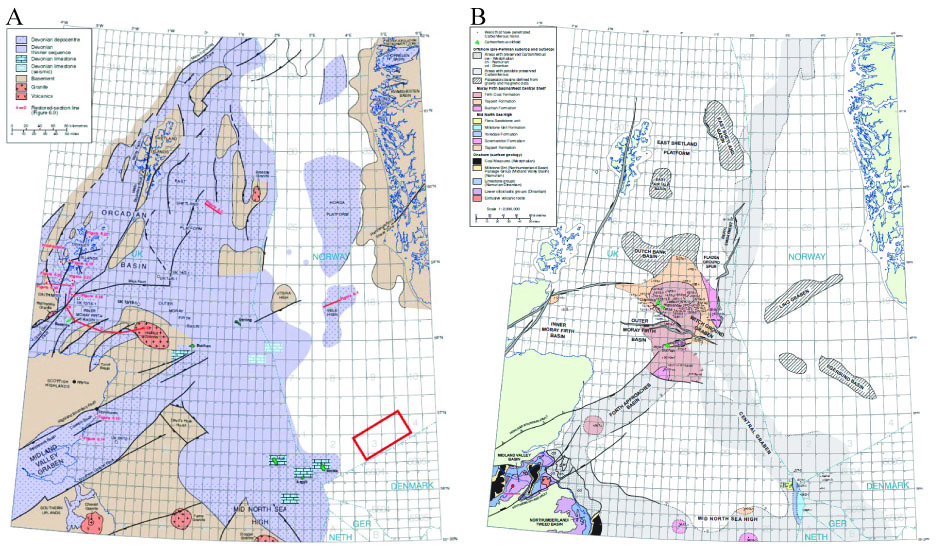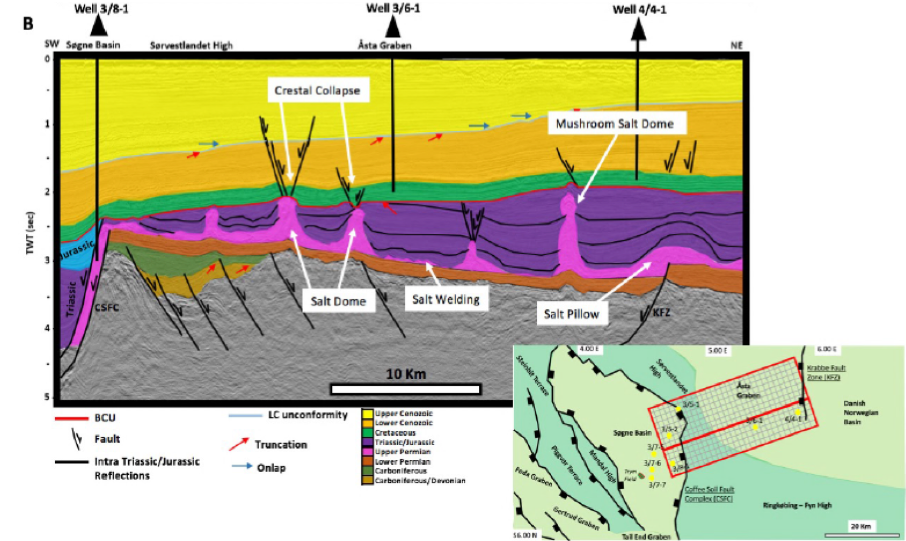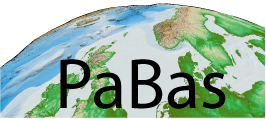Oils are known to have been generated by pre-Jurassic source rocks on the British Continental Shelf (e.g. British Geological Survey 2016, Peters et. al. 1989). The large variation in oil composition in different compartments of the J-Block discussed by Lines and Auld, 2004, may as well reflect contribution from source rocks of various ages. On the Norwegian part of the North Sea Paleozoic generated oils are described from the Embla Field (Pedersen et al., 2006; Ohm et al., 2012; Abay et al., 2014). Matapour and Karlsen (2017) using age specific biomarkers state that Paleozoic derived oils are present in wells 17/3-1 and in 2/4-17.
Despite showing a great success in the UK and Dutch sector, the Paleozoic intervals are still underexplored in the Norwegian sector of the North Sea, see figure A and B below. Some of the biggest discoveries in the UK sector is within in the Devonian sandstones and lacustrine sediments, while for the Dutch and southern North Sea the Carboniferous play model has proven successful.

Figure (A) shows the distribution of known Devonian rocks in the North Sea (Marshall and Hewett, 2003). Red rectangle shows the location of the 3D dataset used by Doudouh (2017) where Paleozoic half grabens have been interpreted; (B) Distribution of Carboniferous rocks in the North Sea (Bruce and Stemmerik, 2003)
Geology of the Sørvestlandet High area as a reference for the study
Based on Doudouh (2017), the preservation of Lower Paleozoic basins (Devonian and Carboniferous) in the Sørvestlandet High and Åsta Graben indicates that the Sørvestlandet High was not a high during the Devonian and Carboniferous, and instead it was characterized by half grabens with a preferential N-S trend. Two main seismic sequences are interpreted within these subbasins: 1) The lower sequence is suggested to be Devonian and is characterized by medium to strong amplitude, sub-parallel to semi-continuous reflectors. No evidence of growth strata was observed, suggesting that it was deposited filling the paleotopography probably inherited from the Caledonian orogeny; and 2) the upper sequence, interpreted as Carboniferous, characterized by chaotic, discontinuous low amplitude reflectors filling the half grabens.
Overlying unconformablythe crystalline basement and the lower Paleozoic half grabens, is the mostly continuous, subparallel and subhorizontal reflectors of the Roteliegendes Group of Lower Permian age. This sequence has been penetrated in the area by well 3/8-1 indicating a sandy unit. The Zechstein Group, upper Permian age, is characterized by salt that has been mobilized during the Triassic-Jurassic, forming salt walls, domes structures, etc. In many places, salt withdrawal has put in contact sediments from the Triassic mini-basins with the Upper Permian sandstones (see figure below).

E-W seismic line showing the main geological elements of Sørvestlandet High. Note the tilting of the high probably as a result of footwall uplift along the Coffee Soil fault, separating the high from the Søgne basin. Also, the Zechstein salt is almost continuous, separating Mesozoic from Paleozoic rocks. (modified from Doudouh 2017).
However, in some areas a thin salt layer seems to separate Lower Permian and older rocks from Triassic rocks. The Triassic-Jurassic is difficult to differentiate and is characterized by parallel, continuous low amplitude reflectors forming mini-basins. The end of this sequence is interpreted as a major period of extension, resulting in footwall uplift of the Sørvestlandet High and erosion forming the Base Cretaceous unconformity. The overlying Cretaceous to recent sequences show mostly continuous and sub parallel reflectors that thicken towards the west and are well known sequences in the area.
Literature:
Abay, T., Karlsen, D., Ohm, S.E., 2014. Vertical Variations in reservoir geochemistry in a Paleozoic trap, Embla Field, offshore Norway: Journal of Petroleum Geology, 37(4), p. 349-372.
Doudouh, L., 2017. Paleozoic-Holocene tectonostratigraphic evolution of the Sørvestlandet High and the Åsta Graben, Southern Norwegian North Sea. Master thesis
Lines, M.D. and Auld, H. A. 2004. A petroleum charge model for the Judy and Joanne Fields, Central North Sea: application to exploration and field development. Geological Society, London, Special Publications, 237, p. 175-206.
Marshall, J.E.A. & Hewitt, A.J., 2003, Devonian. In Evans, D., Graham, C., Armour, A. & Bathurst, P. (eds) The Millennium Atlas: Petroleum Geology of the Central and Northern North Sea. Geological Society, London, p. 65-81.
Matapour, Z. and Karlsen, D.A., 2017. Ages of Norwegian oils and bitumen based on age-specific biomarkers. Petroleum Geoscience. https://doi.org/10.1144/petgeo2016-119.
Ohm, S.E., Karlsen,D.A., Roberts, A., Johannessen, E., Høiland, O., 2006. THE PALEOCENE SANDY SIRI FAIRWAY: AN EFFICIENT “PIPELINE” DRAINING THE PROLIFIC CENTRAL GRABEN ? Journal of Petroleum Geology, 29(1), p. 53-82.
Ohm, S.E., Karlsen, D.A., Phan, N.T., Strand, T. and Iversen, G. 2012. Present Jurassic petroleum charge facing Paleozoic biodegraded oil: Geochemical challenges and potential upsides, Embla field, North Sea. AAPG Bulletin, 96, p. 1523–1552.
Pedersen, J. H., Karlsen, D. A., Lie, J. E., Brunstad, H., di Primio, R., 2006. Maturity and source-rock potential of Paleozoic sediment in the NW European northern Permian Basin: Petroleum Geoscience, v. 12, p. 13-28.
Peters, K. E., Moldowan J. M., Driscole A. R., Demaison G. J. 1989. Origin of Beatrice Oil by Co-Sourcing from Devonian and Middle Jurassic Source Rocks, Inner Moray Firth, United Kingdom. The American Association of Petroleum Geologists Bulletin, 73(4), p. 454-471.
Vane, C. H., Uguna, C., Kim, A. W., Johnson, K., Monaghan, A. A. 2015. Palaeozoic Source Rock Organic Geochemistry of the Central North Sea (CNS). British Geological Survey Commissioned Report, CR/15/132. 105 p.

